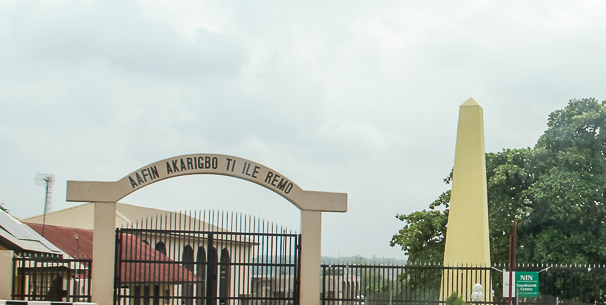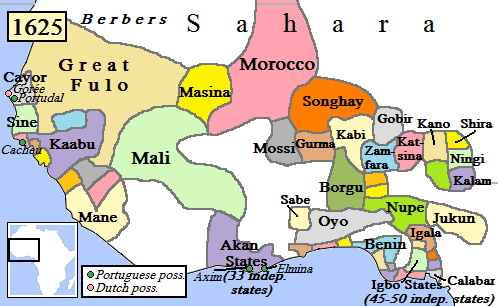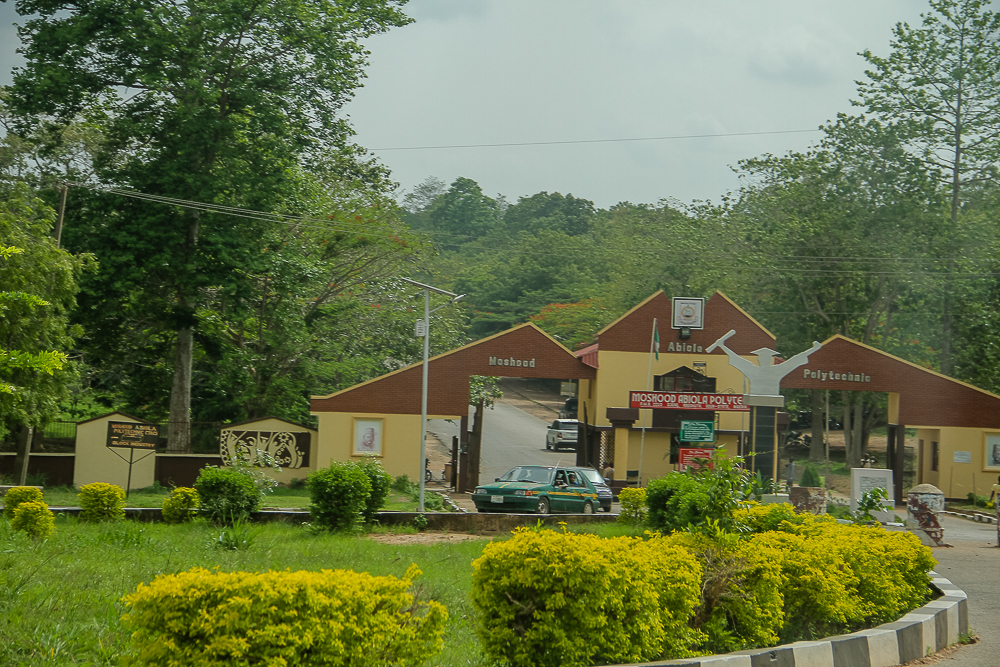|
Akarigbo Of Remo
The Akarigbo of Remoland is the royal title of the paramount ruler of the thirty three (33) towns that makes up the Remo kingdom in Ogun state in Nigeria The capital of the kingdom is Sagamu or Shagamu also known as Ishagamu and it is made up of thirteen (13) of the thirty three towns that make up the Remo Kingdom. The thirteen towns that makes up Sagamu that congregated there in 1872 for greater security are : Offin ( where the Akarigbo's palace is situated), Makun, Sonyindo, Epe, Ibido, Igbepa, Ado, Oko, Ipoji, Batoro, Ijoku, Latawa and Ijagba. The other twenty (20) are: Ipara, Ikenne, Ogere, Okun-owa, Ilisan, Ibese, Ode Remo, Ilara, Isara, Irolu, Akaka, Ikorodu, Odogbolu, Emuren, Imota, Ijede, Gbogbo, Ikosi, and Ijesa-Ijebu. Background The Obas of Remo have been in existence since the founding of the Ijebu Kingdom by a prince of Oyo named Obanta and the arrival of the Prince Akarigbo to the western area of the kingdom roughly around the early 16th century. The title give ... [...More Info...] [...Related Items...] OR: [Wikipedia] [Google] [Baidu] |
Abeokuta
Abeokuta is the capital city of Ogun State in southwest Nigeria. It is situated on the east bank of the Ogun River, near a group of rocky outcrops in a wooded savanna; north of Lagos by railway, or by water. , Abeokuta and the surrounding area had a population of 449,088. Geography and economy Abẹokuta lies in fertile country of wooded savanna, the surface of which is broken by masses of grey granite. It spreads over an extensive area, being surrounded by mud walls 18 miles in extent. Palm oil, lumber, natural rubber, yams, rice, cassava, maize, cotton, other fruits, and shea butter are the chief articles of trade. It is a key export location for cocoa, palm products, fruit, and kola nuts. Both rice and cotton were introduced by the missionaries in the 1850s and have become integral parts of the economy, along with the dye indigo. Abeokuta lies below the Olumo Rock, home to several caves and shrines. The town depends on the Oyan River Dam for its water supply, which ... [...More Info...] [...Related Items...] OR: [Wikipedia] [Google] [Baidu] |
List Of The Lords Of Remo
Remo land is made up of some towns that included Makun, Offin, Ikenne and about thirty (30) other neighboring towns to Ijebu Kingdom in Nigeria. The capital is Sagamu which was settled in 1872 when thirteen towns congregated together for greater security. Remo land was initially settled roughly around the second half of the 15th century and they claimed their ancestry from Iremo in Ile Ife. Although, there is a strong homogeneity in culture with their Ijebu Kingdom neighbor, they however considered themselves not part of Ijebu Kingdom at least based on recent history. They have their own kingdom called Remo land with their own dominant ruling family since around the early 16th century. However, based on past history, there had been periods when they had been vassal kingdom to the Ijebu Kingdom but the Akarigbos had been distinct from the King of Ijebu kingdom from time immemorial This is a list of the Akarigbos of Remo, the Oba or King of Remo Land Kings of Remo # Akarig ... [...More Info...] [...Related Items...] OR: [Wikipedia] [Google] [Baidu] |
Babatunde Adewale Ajayi
Babatunde Adéwálé Àjàyí is a Nigeria monarch. He is the 19th and current Akarigbo of Remo Land , Confederation of towns in ogun state. Early life Born on December 5, 1962 to the Royal Torungunwa Ruling House of Sagamu, Oba Ajayi, obtained a Bachelor of Science degree in Social Sciences at the University of Ibadan between 1981 and 1984 and an Associate Member of the Institute of Chartered Accountants of Nigeria (ICAN) in 1989. He is an expert in Insolvency and Restructuring spanning over 20 years. The new Akarigbo also enrolled for a Law course at the University of Calabar in 1991 and graduated with LLB degree in 1997. He is happily married with children. Kingship Babatunde Àjàyí was elected as the new king after being emerge victorious over the 17 other contestants to succeed the previous king Oba Michael Sonariwo who died in July, 2016 After casting of votes by the kingmakers which included Chief Rasak Akinyemi Salami (Lisa), Chief Abdul Wasiu Awofala (Losi), ... [...More Info...] [...Related Items...] OR: [Wikipedia] [Google] [Baidu] |
Royal Highness
Royal Highness is a style used to address or refer to some members of royal families, usually princes or princesses. Monarchs and their consorts are usually styled ''Majesty''. When used as a direct form of address, spoken or written, it takes the form Your Royal Highness. When used as a third-person reference, it is gender-specific (His Royal Highness or Her Royal Highness, both abbreviated HRH) and, in plural, Their Royal Highnesses (TRH). Origin By the 17th century, all local rulers in Italy adopted the style ''Highness'', which was once used by kings and emperors only. According to Denis Diderot's ''Encyclopédie'', the style of ''Royal Highness'' was created on the insistence of Archduke Ferdinand of Austria, Cardinal-Infante of Spain, a younger son of King Philip III of Spain. The archduke was travelling through Italy on his way to the Low Countries and, upon meeting Victor Amadeus I, Duke of Savoy, refused to address him as ''Highness'' unless the Duke addressed him ... [...More Info...] [...Related Items...] OR: [Wikipedia] [Google] [Baidu] |
Usman Dan Fodio
Usman Ɗan Fodio ( ar, عثمان بن فودي, translit=ʿUthmān ibn Fodio; 15 December 1754 – 20 April 1817) was a Fulani scholar, Sunni Islamic religious teacher, revolutionary, and philosopher who founded the Sokoto Caliphate and ruled as its first caliph. Born in Gobir, Usman was a descendant the Torodbe clans of urbanized ethnic Fulani people living in the Hausa Kingdoms since the early 1400s. In early life, Usman became well-educated in Islamic studies and soon, he began to preach Sunni Islam throughout Nigeria and Cameroon. He wrote more than a hundred books concerning religion, government, culture, and society. He developed a critique of existing African Muslim elites for what he saw as their greed, paganism, violation of the standards of the Sharia. Usman formed and began an Islamic religious and social revolution which spread from Gobir throughout modern Nigeria and Cameroon, and was echoed in a jihad movement led by the Fula people across West Africa. In 1803, h ... [...More Info...] [...Related Items...] OR: [Wikipedia] [Google] [Baidu] |
Oyo Empire
The Oyo Empire was a powerful Yoruba empire of West Africa made up of parts of present-day eastern Benin and western Nigeria (including Southwest zone and the western half of Northcentral zone). It grew to become the largest Yoruba language, Yoruba-speaking state and rose through the outstanding organizational and administrative skills of the Yoruba people, wealth gained from trade, and a powerful cavalry. The Oyo State, Oyo Empire was one of the most politically important states in the entirety of Western Africa from the mid-17th to the late 18th century, and held sway not only over most of the other kingdoms in Yorubaland, but also over nearby African states, notably the Fon people, Fon Kingdom of Dahomey in the modern Republic of Benin on its west. History Legend of origin The origins of the Oyo Empire lie with Oranyan (also known as Oranmiyan), the last prince of the Yoruba Kingdom of Ile-Ife (Ife). Oranmiyan made an agreement with his brother to launch a punitive raid o ... [...More Info...] [...Related Items...] OR: [Wikipedia] [Google] [Baidu] |
Human Migration
Human migration is the movement of people from one place to another with intentions of settling, permanently or temporarily, at a new location (geographic region). The movement often occurs over long distances and from one country to another (external migration), but internal migration (within a single country) is also possible; indeed, this is the dominant form of human migration globally. Migration is often associated with better human capital at both individual and household level, and with better access to migration networks, facilitating a possible second move. It has a high potential to improve human development, and some studies confirm that migration is the most direct route out of poverty.Age is also important for both work and non-work migration. People may migrate as individuals, in family units or in large groups. There are four major forms of migration: invasion, conquest, colonization and emigration/immigration. Persons moving from their home due to forced displa ... [...More Info...] [...Related Items...] OR: [Wikipedia] [Google] [Baidu] |
Dahomey
The Kingdom of Dahomey () was a West African kingdom located within present-day Benin that existed from approximately 1600 until 1904. Dahomey developed on the Abomey Plateau amongst the Fon people in the early 17th century and became a regional power in the 18th century by expanding south to conquer key cities like Whydah belonging to the Kingdom of Whydah on the Atlantic coast which granted it unhindered access to the tricontinental triangular trade. For much of the middle 19th century, the Kingdom of Dahomey became a key regional state, after eventually ending tributary status to the Oyo Empire. European visitors extensively documented the kingdom, and it became one of the most familiar African nations to Europeans. The Kingdom of Dahomey was an important regional power that had an organized domestic economy built on conquest and slave labor, significant international trade and diplomatic relations with Europeans, a centralized administration, taxation systems, and an organ ... [...More Info...] [...Related Items...] OR: [Wikipedia] [Google] [Baidu] |
Ogun State
Ogun State is a state in southwestern Nigeria. Created on 3 February 1976 from the former Western State. Ogun State borders Lagos State to the south, Oyo State and Osun State to the north, Ondo State to the east, and the Republic of Benin to the west. Abeokuta is both Ogun State's capital and most populous city; other important cities in the state include Ijebu Ode, the royal capital of the Ijebu Kingdom, and Sagamu, Nigeria's leading kola nut grower. Ogun state is covered predominantly by rain forest and has wooden savanna in the northwest . Ogun State had a total population of 3,751,140 residents as of 2006, making Ogun State the 16th most populated state in Nigeria In terms of landmass, Ogun State is the 24th largest State in Nigeria with land area of 16,762 kilometer square. Nicknamed the "Gateway to Nigeria", the state is notable for having a high concentration of industrial Estates and being a major manufacturing hub in Nigeria. Major factories in Ogun include the Dangote ... [...More Info...] [...Related Items...] OR: [Wikipedia] [Google] [Baidu] |
History Of Slavery
The history of slavery spans many cultures, nationalities, and religions from ancient times to the present day. Likewise, its victims have come from many different ethnicities and religious groups. The social, economic, and legal positions of enslaved people have differed vastly in different systems of slavery in different times and places. Slavery has been found in some hunter-gatherer populations, particularly as hereditary slavery, but the conditions of agriculture with increasing social and economic complexity offer greater opportunity for mass chattel slavery. Slavery was already institutionalized by the time the first civilizations emerged (such as Sumer in Mesopotamia, which dates back as far as 3500 BC). Slavery features in the Mesopotamian ''Code of Hammurabi'' (c. 1750 BC), which refers to it as an established institution. Slavery was widespread in the ancient world in Europe, Asia, Middle East, and Africa. It became less common throughout Europe during the Early Middl ... [...More Info...] [...Related Items...] OR: [Wikipedia] [Google] [Baidu] |
Prince Akarigbo
A prince is a male ruler (ranked below a king, grand prince, and grand duke) or a male member of a monarch's or former monarch's family. ''Prince'' is also a title of nobility (often highest), often hereditary, in some European states. The female equivalent is a princess. The English word derives, via the French word ''prince'', from the Latin noun , from (first) and (head), meaning "the first, foremost, the chief, most distinguished, noble ruler, prince". Historical background The Latin word (older Latin *prīsmo-kaps, literally "the one who takes the first lace/position), became the usual title of the informal leader of the Roman senate some centuries before the transition to empire, the ''princeps senatus''. Emperor Augustus established the formal position of monarch on the basis of principate, not dominion. He also tasked his grandsons as summer rulers of the city when most of the government were on holiday in the country or attending religious rituals, and, ... [...More Info...] [...Related Items...] OR: [Wikipedia] [Google] [Baidu] |









